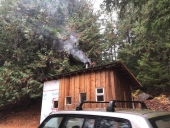Post Today 02:01:18 PM Subject: Greenhouse install: Exhaust pipe gauge etc.
About to get started on a Greenhouse Rocketstove install with the mass being a 15' long bench to germinate seedlings on. While shopping around for exhaust pipe I came across some in 8" x 60" sections but it is 28 ga metal. Is this too thin to hold a whole lot of cob? How much cob could I feel safe about piling on?
Related, is it necessary that the chimney in the heat riser be thick metal (I think it was suggested in the book to be at least 1/4") ? What gauge can this piece be?
28 ga should be fine. Think of the pipe as the form, and the cob as the material that will actually be supporting the weight. If you mix a proper cob, with a lot of sand and a little decent clay, and pack it tightly under and beside the ducting as well as above, you can have an arch-like structure that supports a huge amount of weight.
For a greenhouse, my main concerns would be: 1) including some kind of barrier like a tile or brick layer, so you don't pierce the ducting with a garden fork, and 2) providing a way for your plant-water to drain away outside the bench, if you want to avoid rusting the ducting. Galvanized has some ability to withstand rusting, but clay is very good at holding water, so it's a battle of the nano-materials.
For the heat riser, thicker metal or brick helps with drafting. Also, the temperatures in here can get very high, and we've seen a number of thin steel or duct materials that warped here, or just oxidized and flaked away. Thin firebrick or ceramic chimney liner with a good insulation would be ideal; a cardboard form for a castable material (clay-perlite cob insulation, or castable refractory for over 2800 degrees, 3000 would be better) would be good because the cardboard would burn out; the thicker options in high-temp steel are a third alternative because they are too stiff to warp. They do sometimes break seals from thermal expansion; make sure there is good support and insulation around it.
It also seems that many folks are forgoing the metal drum with top and bung for the wood feed area in favor of one built of bricks. What's the reasoning here? Are small drums difficult to find? Is one preferable?
I'll try to do some documentation along the way for those interested as I've learned a lot from what has already been posted. Thanks!
-Anthony
The small drum around the fuel feed, with a bung hole 'vent' in its shut-down lid, allows you to do a couple of foolish things: 1) pile in wood that doesn't fit the stove, and hope it will burn, and 2) respond to any problems you do have with the stove not drafting properly, smoking back, etc. by putting a lid on it instead of fixing the problem. Putting a lid on it traps the smoke under the lid, but you still can't get to it to make the fire work properly without releasing the smoke into the room. This option is popular to appease a person in the house who is scared of fire, or smoke, or responds to physical challenges by wanting them to go away. It does not fix any of the problems it is designed to address; it only gives an intimidated person a way to 'make it stop' until the main operator can be called to fix the problem.
The plain brick alternative does not trap smoke in a chamber that will eventually be released into the house, does not concentrate heat above the firebox making counter-drafts more likely, and provides more incentive to operate and maintain the stove properly: in order to control shut-down by sliding bricks across it, you have to have your wood cut to a size that actually fits your firebox. You can go up by a half-course of bricks, or a few inches of ceramic tile collar, without creating a big enough void to encourage trapped smoke.
If you have draft problems, you check the ducting for blockages: check that the screen is still over your exhaust and that pack-rats haven't nested in the manifold; take your shop-vac or gnarled little hands and pull the fly ash out of the first section of duct; and make sure there isn't a drift of fly ash on top of the heat riser while you're at it.
If the draft is sluggish because it's cold inside and the weather is warm, you open the doors and let some sunshine in, and put a candle under the heat riser to 'prime' the draft until you can see by the flickering flame that the draft is pulling in the right direction.
It's not a bad idea to have some kind of emergency shut-down option, I don't know, your roofer could hammer the cap onto your chimney while the stove is running and you need to drop a lid over the firebox and go yell at him. Or at the end of the night, you want to close off the draw to keep more heat in the channels once the fire is out.
But adding a taller box to hold this lid encourages putting longer wood in the stove, which leads to exactly the kind of awkward flare-ups that make people want to put a lid on it.
Glad you're having fun, look forward to seeing your project!
-Erica







































